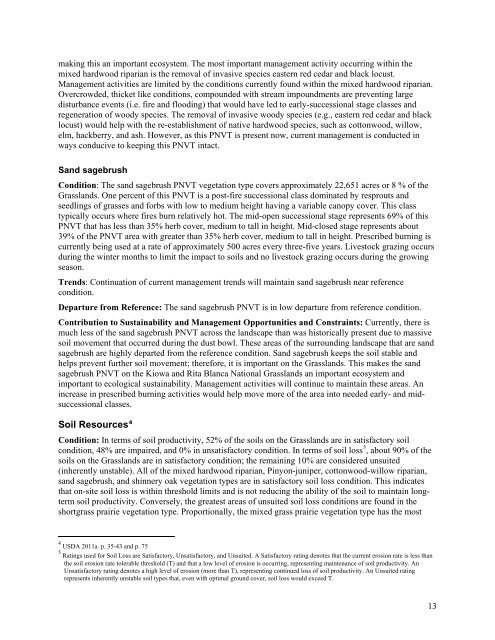Comprehensive Evaluation Report
Comprehensive Evaluation Report
Comprehensive Evaluation Report
You also want an ePaper? Increase the reach of your titles
YUMPU automatically turns print PDFs into web optimized ePapers that Google loves.
making this an important ecosystem. The most important management activity occurring within the<br />
mixed hardwood riparian is the removal of invasive species eastern red cedar and black locust.<br />
Management activities are limited by the conditions currently found within the mixed hardwood riparian.<br />
Overcrowded, thicket like conditions, compounded with stream impoundments are preventing large<br />
disturbance events (i.e. fire and flooding) that would have led to early-successional stage classes and<br />
regeneration of woody species. The removal of invasive woody species (e.g., eastern red cedar and black<br />
locust) would help with the re-establishment of native hardwood species, such as cottonwood, willow,<br />
elm, hackberry, and ash. However, as this PNVT is present now, current management is conducted in<br />
ways conducive to keeping this PNVT intact.<br />
Sand sagebrush<br />
Condition: The sand sagebrush PNVT vegetation type covers approximately 22,651 acres or 8 % of the<br />
Grasslands. One percent of this PNVT is a post-fire successional class dominated by resprouts and<br />
seedlings of grasses and forbs with low to medium height having a variable canopy cover. This class<br />
typically occurs where fires burn relatively hot. The mid-open successional stage represents 69% of this<br />
PNVT that has less than 35% herb cover, medium to tall in height. Mid-closed stage represents about<br />
39% of the PNVT area with greater than 35% herb cover, medium to tall in height. Prescribed burning is<br />
currently being used at a rate of approximately 500 acres every three-five years. Livestock grazing occurs<br />
during the winter months to limit the impact to soils and no livestock grazing occurs during the growing<br />
season.<br />
Trends: Continuation of current management trends will maintain sand sagebrush near reference<br />
condition.<br />
Departure from Reference: The sand sagebrush PNVT is in low departure from reference condition.<br />
Contribution to Sustainability and Management Opportunities and Constraints: Currently, there is<br />
much less of the sand sagebrush PNVT across the landscape than was historically present due to massive<br />
soil movement that occurred during the dust bowl. These areas of the surrounding landscape that are sand<br />
sagebrush are highly departed from the reference condition. Sand sagebrush keeps the soil stable and<br />
helps prevent further soil movement; therefore, it is important on the Grasslands. This makes the sand<br />
sagebrush PNVT on the Kiowa and Rita Blanca National Grasslands an important ecosystem and<br />
important to ecological sustainability. Management activities will continue to maintain these areas. An<br />
increase in prescribed burning activities would help move more of the area into needed early- and midsuccessional<br />
classes.<br />
Soil Resources 4<br />
Condition: In terms of soil productivity, 52% of the soils on the Grasslands are in satisfactory soil<br />
condition, 48% are impaired, and 0% in unsatisfactory condition. In terms of soil loss 5 , about 90% of the<br />
soils on the Grasslands are in satisfactory condition; the remaining 10% are considered unsuited<br />
(inherently unstable). All of the mixed hardwood riparian, Pinyon-juniper, cottonwood-willow riparian,<br />
sand sagebrush, and shinnery oak vegetation types are in satisfactory soil loss condition. This indicates<br />
that on-site soil loss is within threshold limits and is not reducing the ability of the soil to maintain longterm<br />
soil productivity. Conversely, the greatest areas of unsuited soil loss conditions are found in the<br />
shortgrass prairie vegetation type. Proportionally, the mixed grass prairie vegetation type has the most<br />
4 USDA 2011a. p. 35-43 and p. 75<br />
5 Ratings used for Soil Loss are Satisfactory, Unsatisfactory, and Unsuited. A Satisfactory rating denotes that the current erosion rate is less than<br />
the soil erosion rate tolerable threshold (T) and that a low level of erosion is occurring, representing maintenance of soil productivity. An<br />
Unsatisfactory rating denotes a high level of erosion (more than T), representing continued loss of soil productivity. An Unsuited rating<br />
represents inherently unstable soil types that, even with optimal ground cover, soil loss would exceed T.<br />
13
















